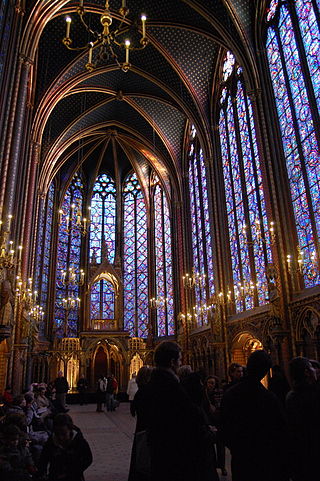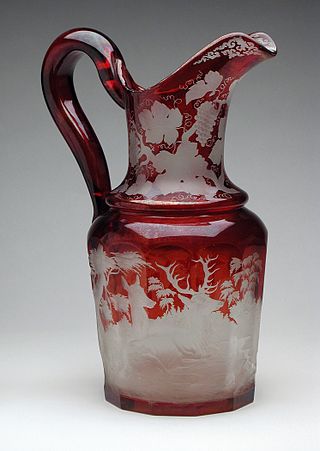Related Research Articles

Hearst Communications, Inc., often referred to simply as Hearst, is an American multinational mass media and business information conglomerate based in Hearst Tower in Midtown Manhattan in New York City.

Stained glass is coloured glass as a material or works created from it. Throughout its thousand-year history, the term has been applied almost exclusively to the windows of churches and other significant religious buildings. Although traditionally made in flat panels and used as windows, the creations of modern stained glass artists also include three-dimensional structures and sculpture. Modern vernacular usage has often extended the term "stained glass" to include domestic lead light and objets d'art created from foil glasswork exemplified in the famous lamps of Louis Comfort Tiffany.

John La Farge was an American artist whose career spanned illustration, murals, interior design, painting, and popular books on his Asian travels and other art-related topics. La Farge made stained glass windows, mainly for churches on the American east coast, beginning with a large commission for Henry Hobson Richardson's Trinity Church in Boston in 1878, and continuing for thirty years. La Farge designed stained glass as an artist, as a specialist in color, and as a technical innovator, holding a patent granted in 1880 for superimposing panes of glass. That patent would be key in his dispute with contemporary and rival Louis Comfort Tiffany.

Thin-layer chromatography (TLC) is a chromatography technique that separates components in non-volatile mixtures.

The Hearst Tower is a building at the southwest corner of 57th Street and Eighth Avenue, near Columbus Circle, in the Midtown Manhattan neighborhood of New York City, United States. It is the world headquarters of media conglomerate Hearst Communications, housing many of its publications and communications companies. The Hearst Tower consists of two sections, with a total height of 597 feet (182 m) and 46 stories. The six lowest stories form the Hearst Magazine Building, designed by Joseph Urban and George B. Post & Sons, which was completed in 1928. Above it is the Hearst Tower addition, which was completed in 2006 and designed by Norman Foster.

Latte macchiato is a coffee beverage. The name is Italian for "stained milk" or "marked milk", referring to the way the drink is prepared by pouring a shot of espresso into steamed milk. It is a play on espresso macchiato, an older drink consisting of espresso marked with a dollop or two of milk or cream.

Venetian glass is glassware made in Venice, typically on the island of Murano near the city. Traditionally it is made with a soda–lime "metal" and is typically elaborately decorated, with various "hot" glass-forming techniques, as well as gilding, enamel, or engraving. Production has been concentrated on the Venetian island of Murano since the 13th century. Today Murano is known for its art glass, but it has a long history of innovations in glassmaking in addition to its artistic fame—and was Europe's major center for luxury glass from the High Middle Ages to the Italian Renaissance. During the 15th century, Murano glassmakers created cristallo—which was almost transparent and considered the finest glass in the world. Murano glassmakers also developed a white-colored glass that looked like porcelain. They later became Europe's finest makers of mirrors.
Mosser Glass is a company making handmade glass, founded in Cambridge, Ohio, in 1970 by Thomas R. Mosser. The company is operated by his oldest son, Tim Mosser. The Mosser family got their start in the business at the Cambridge Glass Company.

Banquet photography is the photography of large groups of people, typically in a banquet setting such as a hotel or club banquet room, with the objective of commemorating an event. Clubs, associations, unions, circuses and debutante balls have all been captured by banquet photographers.

The Fenton Art Glass Company is a glass manufacturer founded in 1905 by brothers Frank L. Fenton and John W. Fenton.

Stained glass conservation refers to the protection and preservation of historic stained glass for present and future generations. It involves any and all actions devoted to the prevention, mitigation, or reversal of the processes of deterioration that affect such glassworks and subsequently inhibit individuals' ability to access and appreciate them, as part of the world's collective cultural heritage. It functions as a part of the larger practices of cultural heritage conservation (conservation-restoration) and architectural conservation.

Medieval stained glass is the coloured and painted glass of medieval Europe from the 10th century to the 16th century. For much of this period stained glass windows were the major pictorial art form, particularly in northern France, Germany and England, where windows tended to be larger than in southern Europe. In some countries, such as Sweden and England, only a small number of original stained windows has survived to this day.

Buster Warenski was an American custom knifemaker from Kimberly, Nevada who made "Art Knives" utilizing gold and other precious metals. Warenski is best known for making a reproduction of King Tut's dagger with a forged gold blade; over 32 ounces of gold were used in the construction of the dagger, making it one of the most valuable knives made in recent years.

Robert Kehlmann is an artist and writer. He was an early spokesperson for evaluating glass art in the context of contemporary painting and sculpture. His glasswork has been exhibited worldwide and is the focus of numerous commentaries. Kehlmann's work can be found in museums and private collections in the United States, Europe and Asia. He has written books, articles, and exhibition reviews for publications in the U.S. and abroad. In 2014 the Rakow Research Library of The Corning Museum of Glass acquired Kehlmann's studio and research archives.
The history of American comics began in the 19th century in mass print media, in the era of sensationalist journalism, where newspaper comics served as further entertainment for mass readership. In the 20th century, comics became an autonomous art medium and an integral part of American culture.
J. H. Hobbs, Brockunier and Company was one of the largest and best known manufacturers of glass in the United States during the 19th century. Its products were distributed world–wide. The company is responsible for one of the greatest innovations in American glassmaking—an improved formula for lime glass that enabled American glass makers to produce high-quality glass at a lower cost. The firm also developed talented glassmakers that started glass factories in Ohio and Indiana.

Angelo Barovier was an Italian glass artist. Raised in a family with a long tradition of glass working, Barovier was certainly the best-known member and significant for uniting the knowledge passed down for generations as an artist and a scientist.

Flashed glass, or flash glass, is a type of glass created by coating a colorless gather of glass with one or more thin layers of colored glass. This is done by placing a piece of melted glass of one color into another piece of melted glass of a different color and then blowing the glass.

A glass blank is a piece of glass that requires additional decoration before it is considered finished. Types of decoration include cutting, engraving, acid-etching, gilding, and enameling. Often the term blank is used in reference to an uncut piece of glass that will be cut or engraved. "Blank" is used in the same way of pottery, especially porcelain, that was often decorated elsewhere, for example by hausmalers.

Art Nouveau glass is fine glass in the Art Nouveau style. Typically the forms are undulating, sinuous and colorful art, usually inspired by natural forms. Pieces are generally larger than drinking glasses, and decorative rather than practical, other than for use as vases and lighting fittings; there is little tableware. Prominently makers, from the 1890s onwards, are in France René Lalique, Emile Gallé and the Daum brothers, the American Louis Comfort Tiffany, Christopher Dresser in Scotland and England, and Friedrich Zitzman, Karl Koepping and Max Ritter von Spaun in Germany. Art Nouveau glass included decorative objects, vases, lamps, and stained glass windows. It was usually made by hand, and was usually colored with metal oxides while in a molten state in a furnace.
References
- ↑ "Flashed? Cased? Stained? Glass decor". www.patternglass.com. Retrieved 2017-07-04.
- ↑ Magazines, Hearst (1936). Popular Mechanics. Hearst Magazines.
- ↑ Shotwell, David J. (2002). Glass A to Z. Krause Publications. p. 77. ISBN 9780873493857.
- ↑ Drachenfels, Suzanne Von (2000-11-08). The Art of the Table: A Complete Guide to Table Setting, Table Manners, and Tableware . Simon and Schuster. p. 285. ISBN 9780684847320.
Cased glass is flashed glass.
- ↑ Shotwell, David J. (2002). Glass A to Z . Krause Publications. ISBN 9780873493857.
Cased glass is flashed glass.